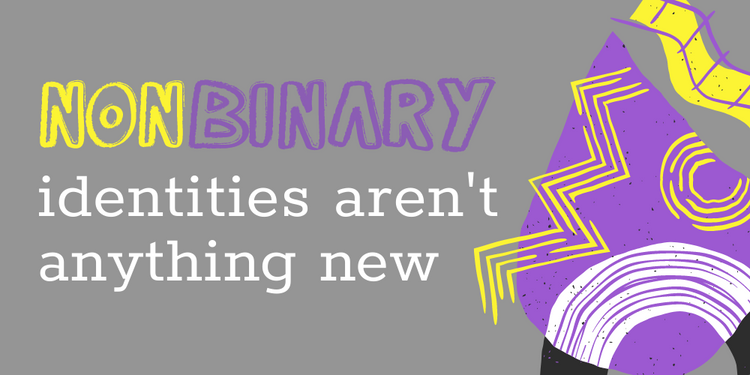Nonbinary History and Definition


by Point Community College Alum Alexzander
Nonbinary Definition and Meaning
Nonbinary is a gender identity and experience that embraces a full spectrum of expressions and ways of being that resonate for an individual. It may be an active resistance to binary gender expectations and/or an intentional creation of new unbounded ideas of self within the world. If you're interested in learning other LGBTQ+ terms & definitions, check out this resource.
A significant portion of the skepticism around nonbinary identities stems from the fact that gender identity is being explored now more than ever. Our society is moving away from strict gender roles and allowing for more variance in gender expression, which encourages people to question and experiment with their own gender identities. This may give the impression that being transgender or nonbinary is a relatively new concept, but that is far from the truth.
What is the history of nonbinary identities?
In fact, one of the earliest known examples of someone who may have identified with the contemporary meaning of “transgender” was documented in the 1620s in the Virginia colony. This referred to a servant by the name of Thomas/Thomasine Hall who claimed to be both a man and a woman, assuming the traditional roles and clothing of both genders. At the time, there was no name for this phenomenon and many settlers simply regarded Hall as an “oddity” to be ridiculed and pitied.

Photo Credit: Digital Transgender Archive
The concept of not identifying with one’s assigned gender wasn’t officially documented until 1910, when German sexologist Dr. Magnus Hirschfeld coined the term “transvestite” in his book “Die Transvestitenin,” creating one of the first modern terms to describe transgender individuals. Although the term is outdated and would be considered derogatory today, its coinage remains a significant aspect of transgender history and supports the idea that transgender people have existed throughout history, simply without a definite label.
As gender-defining terminology continued to expand alongside transgender activism in western societies such as the United States, more specific terms and labels began to appear that would describe gender identities outside of the typical gender binary. One example is the term ‘genderqueer,’ which refers to people who have gender identities other than male and female, or outside of the gender binary. The word ‘genderqueer’ emerged in the 1995 spring newsletter released by The Transexual Menace, a transgender rights activist organization founded in New York City in 1993. The popularization of this term was accelerated by the expansion and ease of access to technology, allowing for more public usage and visibility. Today, the similar term ‘nonbinary’ is also being used to describe gender identities that aren’t fixed as male or female. Both terms have gained steady traction over the years, and have recently gained even more recognition after celebrities such as Ruby Rose and Sam Smith began to speak out on their gender identities and their relationship with the gender binary.
It must also be recognized that gender identities outside of the typical binary have existed for centuries in non-eurocentric cultures. In Native American tribes, such as the Navajo, the term ‘two-spirit’ is used to represent indigenous individuals who are not considered men or women and occupy a distinct gender identity. Traditionally, two-spirit people would often perform the activities of both male and female individuals in their tribe and express their gender variation through their clothing, social roles, and lifestyle. The term two-spirit can also be interpreted in different ways depending on the cultural context of the specific tribe or nation it is used in, with some Native communities utilizing other specific terms in their own language for those who don’t identify as male or female.
"It also be recognized that gender identities outside of the typical binary have existed for centuries in non-eurocentric cultures."
Similarly, in South Asia, there are multiple examples of gender categories outside of male and female, with one of the most common groups being hijras. These are individuals who are often assigned male or intersex at birth yet choose to adopt traditionally feminine roles and clothing in society. In Hindu culture, hijras are known for possessing unique religious power and performing blessings at birth and marriage ceremonies. In 2014, India’s supreme court officially recognized hijra as a valid gender identity, declaring that “the spirit of [India’s] Constitution is to provide equal opportunity to every citizen to grow and attain their potential, irrespective of caste, religion, or gender.” Similarly, even earlier in 2007 and 2013 respectively, Nepal and Bangladesh also moved to officially recognize the hijra gender identity.
Although the existence of genders outside of male and female have not been officially recognized by governments and other institutions until recently, these gender identities have been present consistently throughout history, which dispels the notion that being nonbinary is a new or “trendy” concept. Refusing to acknowledge the existence of nonbinary identities actively disregards the cultural history of many non-eurocentric societies, as well as the unspoken and forgotten history of transgender individuals in westernized nations.

This blog was written by Point Community College Alum Alexzander. Learn more about Point's Community College Program here.
Related Posts
December 09, 2020, Andrae Vigil-Romero

Meet Point Scholar Jessica
What college/university are you attending and what made you choose it? I am attending Dartmouth...
November 23, 2020, Andrae Vigil-Romero

Meet Point Scholar Josh
What college/university are you attending and what made you choose it? Yale University; I wanted to...
January 08, 2021, Andrae Vigil-Romero

Meet Point Scholar Tyler
What college/university are you attending? Clemson University Photo Credit: Clemson University...